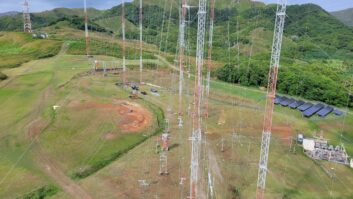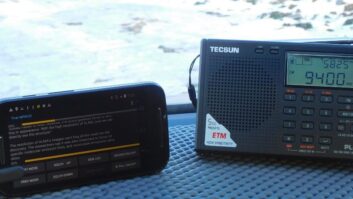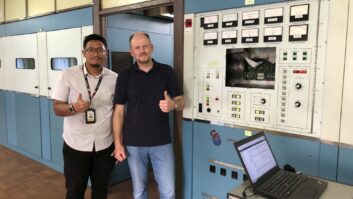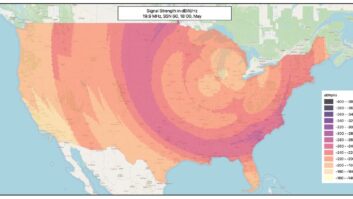There’s no place like Chicago.
Situated on the western edge of Lake Michigan, it is one of the largest cities in the United States. Its greater metro area — estimated at 10 million people or so — extends almost 50 miles inland, stretching up into Wisconsin and down into the northwestern part of Indiana.
For most of the 20th century, Chicago was the second largest city in the United States after New York, a fact that earned it the nickname “Second City.” This was a disparaging term out of New York but later appropriated by the city’s famous improv troupe whose alumni include Bill Murray, Stephen Colbert and Tina Fey.
Chicago is famous for its rebirth after the tragic fire of 1871, the Prohibition gangster heydey of Al Capone, the grandeur of its tall towers and the passion of its arts scene. However, there’s one piece of this city’s history that’s less widely known: its role in the days of broadcasting via shortwave before World War II.
In the mid-1930’s, the total number of shortwave stations on the air in Chicagoland was more than 50. Most of these were in use either for direct communication with other stations or for the broadcast of experimental TV or for the old Apex system of program broadcasting that pre-dates FM use. However, sufficient evidence exists for us to presume that a dozen or so of these shortwave stations were actually on the air during the pre-war years, with broadcast radio programming for direct reception by shortwave listeners in the United States and beyond.
On June 1, 1927, Samuel Insull, owner of the Great Lakes Broadcasting Co., bought the highly popular medium-wave station WENR from E.N. Rauland, owder of the All-American Radio Corp, headquartered in Chicago. The sale was finalized on April 17, 1928 with the transfer of $1.5 million. If that sum sounds big today, imagine what it was back then!

What broadcasting looked like in NBC’s Chicago studio, early 1930s. From John Schneider’s photo collection.
Before the sale even finalized, Insull’s company had applied to the Department of Commerce for a license to operate a special land station on 1040 kHz under the call sign 9XF. Almost immediately, plans were made to build a complete new broadcasting station at an outer suburban location in Downer’s Grove, a facility that would include offices, studios and several transmitters.
The brand-new headquarters for the two stations was launched in the middle of 1929, the year the Department of Commerce approved an extension of the 9XF license to include three shortwave channels: 6020 kHz, 11800 kHz and 21500 kHz.
At WENR, the transmitter was a 50 AM medium-wave unit; W9XF used a 5 kilowatt shortwave unit. In all likelihood, the shortwave transmitter used for W9XF also was used for an experimental mechanical televisions station called W9XR, also owned by Great Lakes.
Incredibly, shortwave W9XF showed up in logs from Australia in August of 1930, on 6120 kHz with a program relay from medium-wave WENR, which was at that point operating its on-air studios in the electrical generating plant of Commonwealth Edison, at 72 West Adams St., near Grant Park.
Despite some success, however, GLB sold its radio and TV facilities a few months later, including the Downer’s Grove station, to a new kid out of New York: the National Broadcasting Co.
When NBC took over, it stated that the shortwave broadcasts from W9XF would continue with programming from the Blue network, though they did close the mechanical TV service from W9XR. New NBC studios in Chicago were installed in the Merchandise Mart, featured in a 1932 article in Broadcast News magazine. The Merchandise Mart remains the “world’s largest commercial building” to this day, according to its website.
Programming from NBC was broadcast over several transmitters including WENR, WMAQ and W9XF. Interestingly, an additional call sign was taken into use for W9XF, in 1933; this was W9XQ. Both call signs were in use on the same channel, 6100 kHz, at the same power level, 5 kW.
In 1937, NBC lodged a request with the FCC to install a 50 kW shortwave transmitter, but this was denied. The reason behind the rejection may have been that NBC already was involved with a large shortwave station located at Bound Brook, N.J.
At any rate, programming from NBC’s WENR-WMAQ over the shortwave outlet W9XF stayed on the air about a decade, heard throughout the United States, Europe, South America and the South Pacific, even as far away as New Zealand.
In April 1932, American radio magazine Broadcast News stated that the New Zealand Broadcasting Service “has had remarkably good results in re-broadcasting signals from this station” — even at a time when the power of the transmitter would have been rated at just 5 kW.
The shortwave service closed entirely in late 1938, when the WENR-WLS transmitters were re-sited to Tinley Park.
The Downer’s Grove site was sold to Frank J. Curran in 1942 to be used as a wartime manufacturing facility during World War II. After the war, it followed a story familiar to many industrial sites in this country: the facility was used to make small items like mothballs, plastic ashtrays and disinfectant cakes, but after manufacturing ceased there in 1990, the building fell into ruin, demolished six years later to make way for a townhouse development.
Sadly, all good things must come to an end.
Dr. Adrian M. Peterson is coordinator of international relations and DX editor for Adventist World Radio.











